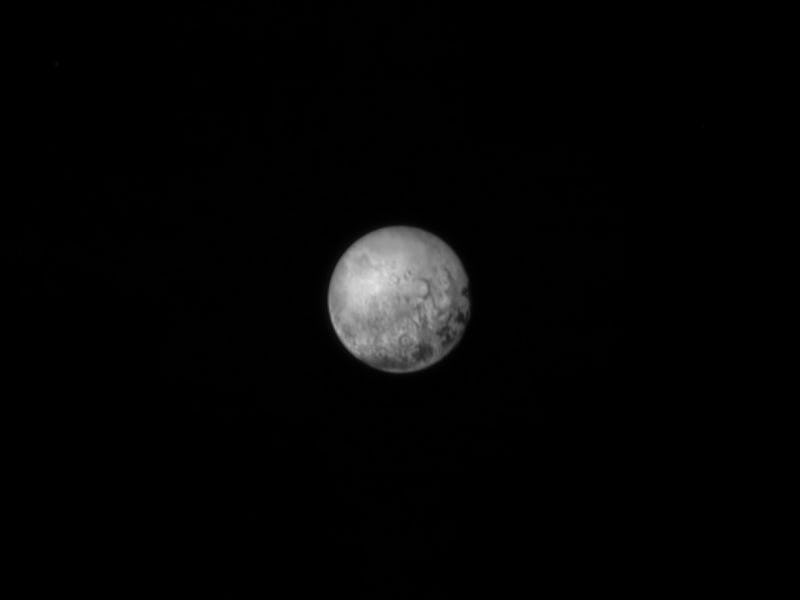Pluto Updates From Space, Earth
Nine years and three billion miles later, we finally did it.

It’s a story 9 years in the making: NASA’s New Horizons spacecraft, which launched in 2006, made its way through our solar system and has now reached Pluto and its five moons. The probe is zipping so quickly through space that it covered the tiny sorta-planet’s diameter in just a few minutes, but those few minutes made epic space history. The probe came closest to Pluto at 7:49 a.m. today, but the data it sends back to Earth won’t reach us until tomorrow morning. Here’s what’s happened so far.
UPDATE: The western part of the Tombaugh Region has revealed carbon monoxide ice, as shown in the green area below. The concentration of the frozen gas is highest in the middle.
UPDATE: In the southern end of Pluto’s heart, which is being informally referred to as “Tombaugh’s Region,” lies a region of mysterious icy plains resembling frozen mud cracks on Earth. For now, scientists are referring to this frozen region as “Sputnik Plain,” after Earth’s first artificial satellite.
UPDATE: A new close-up of Charon reveals a strange depression with a peak in the middle, as shown in the top left of the inset below.
UPDATE: Scientists are surprised at how few craters there are on Charon, the largest of Pluto’s five moons. Its relative smoothness suggests that it’s a young surface that may have been reshaped by geologic activity. They’re waiting on higher-res images to figure out what that dark patch near the moon’s north pole really is.
UPDATE: The irregular shape and size of Hydra, one of Pluto’s moons, has been confirmed. We’re still waiting on the photo, but it’s about 20 by 27 miles — oddly “potato-shaped.”
UPDATE: Here’s an even closer shot of Pluto’s mountains, right by the equator. Scientists are especially excited about the idea that these mountains are no more than 100 million years old and could still be geologically active.”This is one of the youngest surfaces we’ve ever seen in the solar system,” said Jeff Moore of the New Horizons Geology, Geophysics and Imaging Team.
UPDATE: Photos are in. Here’s a closeup on something scientists weren’t expecting — mountains. Big ones. Some of them rise over 11,000 feet above Pluto’s surface.
UPDATE: New Horizons phoned home today at 8:55 p.m. EST, confirming that it’s safe and sound after its successful Pluto flyby. Onward to the Kuiper Belt.
UPDATE: Here’s a sweet animation of how far we’ve come since Pluto’s discovery in 1930 by Clyde W. Tombaugh, whose ashes are being carried on the New Horizons spacecraft.
UPDATE: You know you’ve made it when Stephen Hawking congratulates you. You go, NASA.
UPDATE: The probe’s zipping past Pluto’s system, snapping its last photos of Nix. Now it’s headed straight for the Kuiper belt.
UPDATE: Flying past Charon’s shadow, New Horizons tweeted about getting a better look at Hydra, another of Pluto’s moons.
UPDATE: Here’s a simulation of what it looked like as New Horizons completed its Pluto flyby.
UPDATE: New Horizons isn’t just taking photos. It’s also rapidly collecting data on Pluto’s geology and atmosphere, which could shed light on the origins of our solar system.
UPDATE: One of the first images of Pluto shows the bright, mysterious “heart” at its center, which spans about 1,000 miles across. NASA reports that this area is geologically quite featureless — which could be a sign of ongoing geologic activity. This photo was taken on July 13 from a distance of 476,000 miles.
UPDATE: New Horizons won’t stop once it reaches Pluto — it’s moving way too fast. Its next stop is the asteroid-filled Kuiper Belt, as described in this NASA video.
UPDATE: Scientists have been debating Pluto’s size since 1930. Images from New Horizons have finally settled it. With a diameter of 1,473 miles, it’s a lot bigger than previous estimates. That’s probably because it’s got a lower density, shallower troposphere, and more ice in its interior than anyone ever thought.
UPDATE: Last night, New Horizons entered the Pluto system, sending us the first images of Charon, the largest of Pluto’s five moons. It’s got a lot more chasms, craters, and geologic activity than anyone ever thought. There’s also a mysterious dark region that spans about 200 miles near the north.